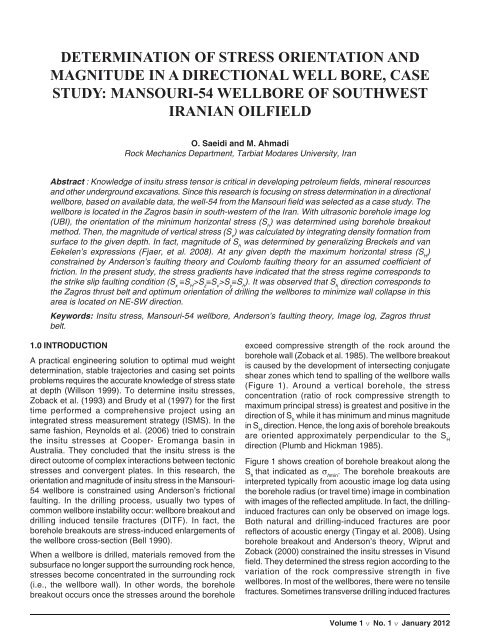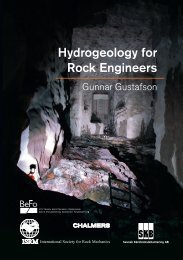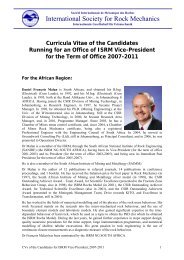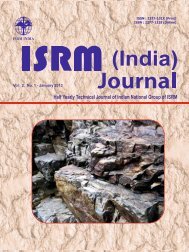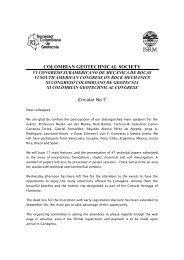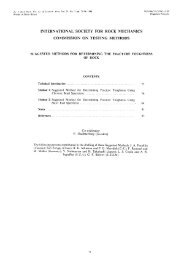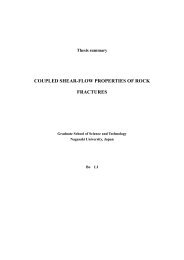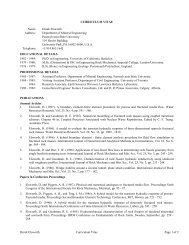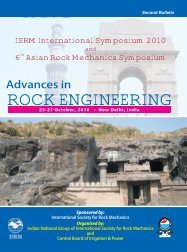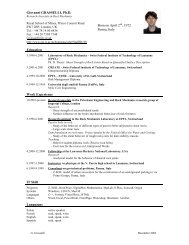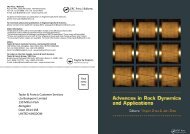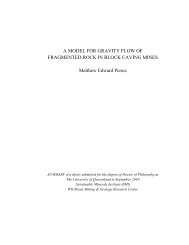ISSN - ISRM
ISSN - ISRM
ISSN - ISRM
You also want an ePaper? Increase the reach of your titles
YUMPU automatically turns print PDFs into web optimized ePapers that Google loves.
25DETERMINATION OF STRESS ORIENTATION ANDMAGNITUDE IN A DIRECTIONAL WELL BORE, CASESTUDY: MANSOURI-54 WELLBORE OF SOUTHWESTIRANIAN OILFIELDO. Saeidi and M. AhmadiRock Mechanics Department, Tarbiat Modares University, IranAbstract : Knowledge of insitu stress tensor is critical in developing petroleum fields, mineral resourcesand other underground excavations. Since this research is focusing on stress determination in a directionalwellbore, based on available data, the well-54 from the Mansouri field was selected as a case study. Thewellbore is located in the Zagros basin in south-western of the Iran. With ultrasonic borehole image log(UBI), the orientation of the minimum horizontal stress (S h) was determined using borehole breakoutmethod. Then, the magnitude of vertical stress (S v) was calculated by integrating density formation fromsurface to the given depth. In fact, magnitude of S hwas determined by generalizing Breckels and vanEekelen’s expressions (Fjaer, et al. 2008). At any given depth the maximum horizontal stress (S H)constrained by Anderson’s faulting theory and Coulomb faulting theory for an assumed coefficient offriction. In the present study, the stress gradients have indicated that the stress regime corresponds tothe strike slip faulting condition (S x≡S H>S z≡S v>S y≡S h). It was observed that S hdirection corresponds tothe Zagros thrust belt and optimum orientation of drilling the wellbores to minimize wall collapse in thisarea is located on NE-SW direction.Keywords: Insitu stress, Mansouri-54 wellbore, Anderson’s faulting theory, Image log, Zagros thrustbelt.1.0 INTRODUCTIONA practical engineering solution to optimal mud weightdetermination, stable trajectories and casing set pointsproblems requires the accurate knowledge of stress stateat depth (Willson 1999). To determine insitu stresses,Zoback et al. (1993) and Brudy et al (1997) for the firsttime performed a comprehensive project using anintegrated stress measurement strategy (ISMS). In thesame fashion, Reynolds et al. (2006) tried to constrainthe insitu stresses at Cooper- Eromanga basin inAustralia. They concluded that the insitu stress is thedirect outcome of complex interactions between tectonicstresses and convergent plates. In this research, theorientation and magnitude of insitu stress in the Mansouri-54 wellbore is constrained using Anderson’s frictionalfaulting. In the drilling process, usually two types ofcommon wellbore instability occur: wellbore breakout anddrilling induced tensile fractures (DITF). In fact, theborehole breakouts are stress-induced enlargements ofthe wellbore cross-section (Bell 1990).When a wellbore is drilled, materials removed from thesubsurface no longer support the surrounding rock hence,stresses become concentrated in the surrounding rock(i.e., the wellbore wall). In other words, the boreholebreakout occurs once the stresses around the boreholeexceed compressive strength of the rock around theborehole wall (Zoback et al. 1985). The wellbore breakoutis caused by the development of intersecting conjugateshear zones which tend to spalling of the wellbore walls(Figure 1). Around a vertical borehole, the stressconcentration (ratio of rock compressive strength tomaximum principal stress) is greatest and positive in thedirection of S hwhile it has minimum and minus magnitudein S Hdirection. Hence, the long axis of borehole breakoutsare oriented approximately perpendicular to the S Hdirection (Plumb and Hickman 1985).Figure 1 shows creation of borehole breakout along theS hthat indicated as σ hmin. The borehole breakouts areinterpreted typically from acoustic image log data usingthe borehole radius (or travel time) image in combinationwith images of the reflected amplitude. In fact, the drillinginducedfractures can only be observed on image logs.Both natural and drilling-induced fractures are poorreflectors of acoustic energy (Tingay et al. 2008). Usingborehole breakout and Anderson’s theory, Wiprut andZoback (2000) constrained the insitu stresses in Visundfield. They determined the stress region according to thevariation of the rock compressive strength in fivewellbores. In most of the wellbores, there were no tensilefractures. Sometimes transverse drilling induced fracturesVolume 1 v No. 1 v January 2012


